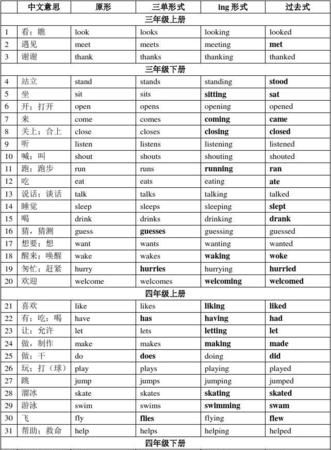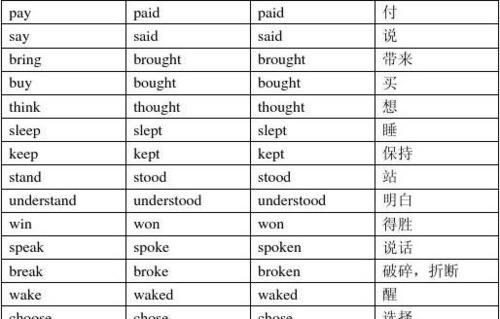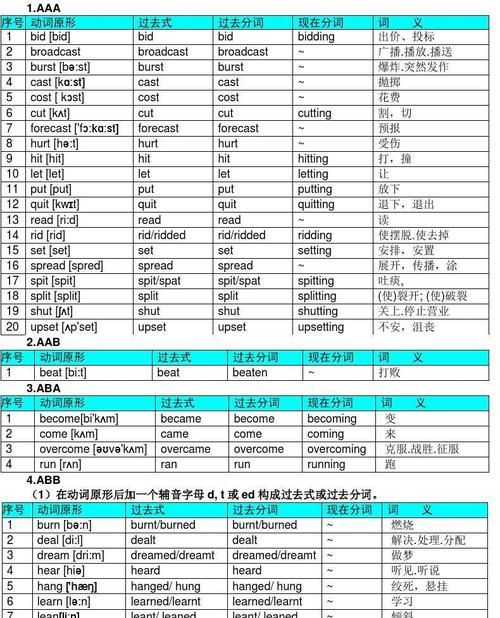本文目录
三至六年级英语动词
一至六年级的英语动词有be动词、情态动词、助动词、行为动词。
一、be动词(am,is,are,was,were )
1、amwas,is was,are--were口诀:我用am,你用are,is用在他她它,所有复数全用are。
2、肯定和否定句I am (not) from London. He is(not) a teacher. She is(not) in the dining room. My hair is(not) long. Her eyes are(not) small.
3、一般疑问句Am I a Chinese? Yes,you are. No,you arent. Are they American? Yes,they are. No,they arent. Is the cat fat? Yes,it is. No,it isnt.
4、be动词的否定形式:am not(没有缩写形式),are not = arent,is not = isnt.

二、助动词(do,does,did )
do,does用于一般现在时,其过去式did用于一般过去时。它们通常用在疑问句和否定句中。它们的否定形式:do not = dont,does not = doesnt,did not = didnt.
注意:在一般现在时中,does用于第三人称单数,其余一律用助动词do;助动词do,does,did后面一定要用动词原形。
三、情态动词
情态动词也是一类特殊的动词,平时我们不把它说成是动词。情态动词可以和行为动词同时出现在同一个句子中。我们现在学过的情态动词有:can、could、shall、should、will、would、may、might、must.注意:情态动词后动词总是用原形。(不受其他任何条件影响)
四、行为动词
就是平时上课时说的动词,表示某一动作或行为。如:sweep、live等。行为动词我们已学过它们的四种形式:原形、第三人称单数+s/es、现在分词(也叫动名词)+ing、过去式+ed。
动词第三人称单数变化规则:
A、一般直接加s,如:play plays,visit visits,speak speaks.
B、以s,x,sh,ch结尾时,加es,如:catch catches,watch watches.
C、以辅音字母+y结尾时,变y为i再加es,如:carry carries,study studies.
小学常用动词的三种形式至少40个英语
do-did-done
go-went-gone
eat-ate-eaten
take-took-taken
have-had-had
动词原形—过去式—第三人称单数—现在分词
clean –cleaned—cleans—cleaning
swim—swam—swims—swimming
love—loved—loves—loved
make—made—makes—making
laugh—laughed—laughs—laughing
play—played—plays—playing
run—ran—runs—running
stamp—stamped—stamps—stamping
fly—flew—flies—flying
sing—sang—sings—singing
clap—clapped—claps—clapping
have—had—has—having
climb—climbed—climbs—climbing
read—read—reads—reading
watch—watched—watches—watching
copy—copied—copies—copying
see—saw—sees—seeing
become—became—becomes—becoming
begin—began—begins—beginning
catch—caught—catches—catching
come—came—comes—coming
do—did—does—doing
drink—drank—drinks—drinking
eat—ate—eats—eating
get—got—gets—getting
go—went—goes—going
give—gave—gives—giving
run—ran—runs—running
sing—sang—sings—singing
take—took—takes—taking
teach—taught—teaches—teaching
回答者: 好就j - 实习生 一级 2009-9-25 20:19
一. 词汇
⑴ 单词
1. 介词:in, on, under, behind, near, at, of
1). in表示"在……中", "在……内"。例如:
in our class 在我们班上
in my bag 在我的书包里
in the desk 在桌子里
in the classroom 在教室里
2). on 表示"在……上"。例如:
on the wall 在墙上
on the desk 在桌子上
on the blackboard 在黑板上
3). under表示"在……下"。例如:
under the tree 在树下
under the chair 在椅子下
under the bed 在床下
4). behind表示"在……后面"。例如:
behind the door 在门后
behind the tree 在树后
5). near表示"在……附近"。例如:
near the teacher's desk 在讲桌附近
near the bed 在床附近
6). at表示"在……处"。例如:
at school 在学校
at home 在家
at the door 在门口
7). of 表示"……的"。例如:
a picture of our classroom 我们教室的一幅画
a map of China 一张中国地图
2. 冠词 a / an / the:
冠词一般位于所限定的名词前,用来署名名词所指的人或事物。冠词有不定冠词和定冠词两种。不定冠词有两个形式,即a和an。a用在以辅音音素开头的词前,如a book; an用在以元音音素开头的字母前,如an apple.
a或an与可数名词单数连用,泛指某类人或某物中的一个。
This is a cat.
这是一只猫。
It's an English book.
这是一本英语书。
His father is a worker.
他的爸爸是个工人。
the既可以用在可数名词前,也可以用在不可数名词前,表示某个或某些特定的人或事物,也可以指上文提到过的人或事物。
Who's the boy in the hat?
戴帽子的男孩是谁呀?
------ What can you see in the classroom?
------ I can see a bag.
------ Where's the bag?
------ It's on the desk.
------- 你能在教室里看到什么呀?
------ 我能看见一个书包。
------ 书包在哪呀?
------ 在桌子上。
3.some和any
①在肯定句中用some.例如:
There are some books on the desk.桌子上有一些书。
Lucy has some good books露西有一些好书。
②在疑问句和否定句中用any。例如:
Is there any ink in your pen?你的钢笔里有墨水吗?
Do you have any brothers and sisters?你有兄弟姐妹吗?
There isn't any water in the glass.杯子里没有水。
⑵记住它们的特殊用法。
①some亦可用于表示盼望得到对方肯定的答复或表示建议、委婉请求的疑问句中,这一点我们不久就会学到。例如:
Would you like to have some apples?你想吃苹果吗?
②any也可用于肯定句中,表示"任何的"。例如:
Any one of us can do this.我们当中任何一个都能做这个。
some 和any的用法是经常出现的考点,希望大家能准确地掌握它们的用法。
4.family
family看作为一个整体时,意思是"家庭",后面的谓语动词be用单数形式 is ;如把family看作为家庭成员时,应理解为复数,后面的谓语动词be应用are。
My family is a big family. 我的家庭是个大家庭。
My family are all at home now. 我的家人现在都在家。
Family强调由家人组成的一个集体或强调这个集体中的成员。home指个人出生、被抚养长大的环境和居住地点。 house指"家"、"房屋",侧重居住的建筑本身。
His family are all workers. 他的家人都是工人。
My home is in Beijing. 我的家在北京。
He isn't at home now. 他现在不在家。
It's a picture of my family. 这是一张我全家的照片。
5. little的用法
a little dog 一只小狗,a little boy 一个小男孩。little常用来修饰有生命的名词。
*但little还可表示否定意义,意为"少的",加不可数名词。
There is little time. 几乎没时间了。
There is little water in the cup. 杯中水很少。
⑵ 词组
on the desk 在桌子上
behind the chair 在椅子后
under the chair 在椅子下面
in her pencil-box 在她的铅笔盒中
near the door 在门附近
a picture of a classroom 一个教室的图片
look at the picture 看这张图片
the teacher's desk 讲桌
a map of China 一张中国地图
family tree 家谱
have a seat 坐下,就坐
this way 这边走
二. 日常用语
1. Come and meet my family.
2. Go and see. I think it's Li Lei.
3. Glad to meet you.
4. What can you see in the picture?
I can see a clock / some books.
5. Can you see an orange?
Yes, I can. / No, I can't.
6. Where's Shenzhen?
It's near Hong Kong.
7. Let me see.(口语)让我想想看。
see 在这是"明白、懂了",不可译作"看见"。例如:
8. Please have a seat.
seat表示"座位",是个名词。have a seat表示"就坐",也可以说take a seat, 和sit down的意思相同。
三. 语法
1. 名词所有格
名词如要表示与后面名词的所有关系,通常用名词所有格的形式,意为"……的"。一般有以下几种形式:
(1). 一般情况下在词尾加"'s"。例如:
Kate's father Kate的爸爸
my mother's friend 我妈妈的朋友
(2). 如果复数名词以s结尾,只加"'"。例如:
Teachers' Day 教师节
The boys' game 男孩们的游戏
(3). 如果复数名词不以s结尾,仍加"'s"。例如:
Children's Day 儿童节
Women's Day 妇女节
(4). 表示两个或几个共有时,所有格应加在后一个名词上。例如:
Lucy and Lily's room Lucy 和Lily的房间
Kate and Jim's father Kate 和Jim的爸爸
动物和无生命事物的名词的所有格一般不在词尾加"'s",而常常用介词of的短语来表示。
a map of China 一幅中国地图
the name of her cat 她的猫的名字
a picture of my family 我的家庭的一张照片
the door of the bedroom 卧室的门
2. 祈使句
祈使句主要用来表示说话人的请求、命令、建议、叮嘱等意图。祈使句一般不用主语,读时用降调。为使语气委婉、礼貌,常在句首或句尾加please 。在句尾时,please前多用逗号。
(1). 祈使句肯定形式的谓语动词一律用动词原形。
Go and see. 去看看。
Come in, please. 请进。
(2). 祈使句的否定形式常用don't于句首。
Don't look at your books. 不要看书。
Don't play on the road. 不要在马路上玩。
3. There be 的句子结构
There be是一个"存在"句型,表示"有"的意思,
肯定句的形式为:There be + 名词(单数或复数)+地点状语或时间状语。
be动词单复数的确定,看be后边第一个名词,当所接主语为单数或不可数名词时,be动词形式为is;当所接主语为复数名词时,be动词为are;当be动词后接两个以上主语时,be动词与最临近主语保持数上的一致。意思为"某地有某人或某物"。如:
There is an eraser and two pens on the desk. 桌子上有一块橡皮和两支钢笔。
There are two pens and an eraser on the desk. 桌上有两支钢笔和一块橡皮。
(1)there be的否定句,即在be的后面加上not。
否定形式为:There be + not + (any) + 名词+地点状语。
There is not any cat in the room. 房间里没猫。
There aren't any books on the desk. 桌子上没书。
(2)there be句型的疑问句就是将be提到句首:Be there + (any) +名词+地点状语?肯定回答:Yes, there is / are. 否定回答:No, there isn't / aren't.
---Is there a dog in the picture? 画上有一只狗吗?
---Yes, there is. 有。
---Are there any boats in the river? 河里有船吗?
---No, there aren't. 没有。
(3)特殊疑问句:How many . . . are there (+地点状语)?"某地有多少人或物?"回答用There be . . .
There's one. / There are two / three / some . . .
有时直接就用数字来回答。One. / Two . . .
---How many students are there in the classroom? 教室里有多少学生?
---There's only one. / There are nine. 只有一个。/有九个。
(4)如果名词是不可数名词,用:How much + 不可数名词 + is there + 地点状语?
How much water is there in the cup? 杯中有多少水?
How much food is there in the bowl? 碗里有多少食物?
回答者: 韦灵透 - 见习主管 五级 2009-9-25 20:23
动词原形—过去式—第三人称单数—现在分词
clean –cleaned—cleans—cleaning
swim—swam—swims—swimming
love—loved—loves—loved
make—made—makes—making
play—played—plays—playing
run—ran—runs—running
stamp—stamped—stamps—stamping
fly—flew—flies—flying
sing—sang—sings—singing
clap—clapped—claps—clapping
have—had—has—having
climb—climbed—climbs—climbing
read—read—reads—reading
watch—watched—watches—watching
copy—copied—copies—copying
see—saw—sees—seeing
become—became—becomes—becoming
begin—began—begins—beginning
catch—caught—catches—catching
come—came—comes—coming
do—did—does—doing
drink—drank—drinks—drinking
eat—ate—eats—eating
get—got—gets—getting
go—went—goes—going
give—gave—gives—giving
run—ran—runs—running
sing—sang—sings—singing
take—took—takes—taking
teach—taught—teaches—teaching

be动词的三种形式
1.现在进行时:be+动词-ing形式.
2.一般过去时:动词-ed形式,当然还有不规则的动词变化.
3.一般将来时:be going to +动词原形
will+动词原形
除了这三种基本的时态以外,还有根据这三种衍生的,比如:
过去进行时was/were+动词-ing形式
过去将来时was/were going to +动词原形,would +动词原形
还有动词的被动语态:be +动词过去分词.
现在完成时:have/has +动词过去分词.

英语动词+动词的三种形式
will would (无进行时态) will 下决心
2.愿意
fly flew flying flies 飞;飞行
fall fell falling falls 落下;跌倒;下降;减少
dress dressed dressing dresses 给...穿衣;打扮;包扎
write wrote writing writes 写
predict predicted predicting predicts 预测
come came coming comes 来自
think thought thinking thinks 认为;思考
make made making makes 让;使得
seem seemed (无进行时态) seems 似乎
play played playing plays 玩
argue argued arguing argues 争辩
could could (无进行时态) could 能够
surprise surprised surprising surprises 使...吃惊
bake baked baking bakes 烤制
fail failed (无进行时态) fails 失败
return returned returning returns 归还
fit fitted (无进行时态) fits 适合
complain complained complaining complains 抱怨
include included including includes 包括;包含
push pushed pushing pushs 推
send sent sending sends 发送
compare compared comparing compares 对比
buy bought buying buys 买
land landed landing lands着陆
imagine imagined imagining imagines 想像
follow followed following follows 跟随
kid kidded kidding kids 耍弄
climb climbed climbing climbs 攀爬
jump jumped jumping jumps 跳跃
shout shouted shouting shouts 射击
ride rode riding rides 骑
run ran running runs 跑
meet met meeting meets 遇见
happen happened happening happens 发生
hear heard hearing hears 听到
kill killed killing kills 杀
murder murdered murdering murders 谋杀
ring rang ringing rings 响铃
tell told telling tells 告诉
close closed (无进行时态) close 关闭
destroy destroyed destroying destroys毁灭
become became becoming becomes变成
suppose supposed supposing supposes假使
copy copied copying copies复制
eat ate eating eats吃
return returned returning returns
organize organized organizing organizes
collect collected collecting collects
store stored storing stores
be was/were being am/is/are
bring brought bringing brings
miss missed missing misses
annoy annoyed annoying annoys
cough coughed coughing coughs
break broke breaking breaks
smoke smoked smoking smokes
criticize criticized criticizing criticizes
drop dropped dropping drops
pick picked picking picks
behave (名词是behavior行为)
receive received receiving receives
choose chose choosing chooses
open opened opening opens
cost cost costing costs
give gave giving gives
enter entered entering enters
sing sang singing sings
encourage encouraged encouraging encourages
suggest suggested suggesting suggests
mention mentioned (无进行时态) mentions
see saw seeing sees
fear feard (无进行时态) fears
wake woke waking wakes
cross crossed crossing crosses

以上就是关于六上英语常见动词的三种形式 ,三至六年级英语动词的全部内容,以及六上英语常见动词的三种形式 的相关内容,希望能够帮到您。

